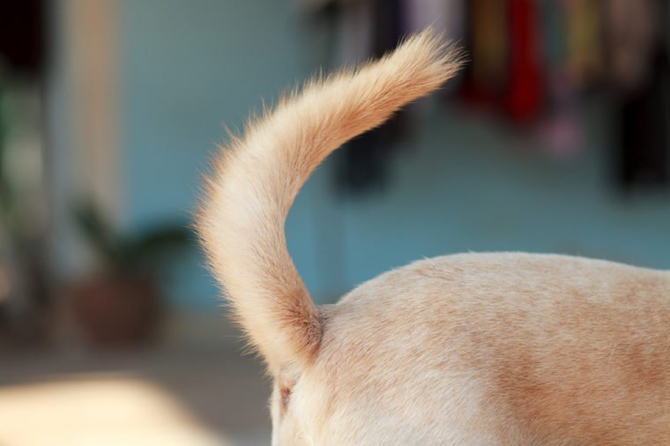A wagging tail is a sign of communication, right? Yes, but did you know that a wagging tail isn’t always associated with feelings of happiness? Read on to discover what dog tail wagging really means.
According to Psychology Today, pet professionals and pet owners alike can use dog tail wagging to assess the emotional state of a dog. However, many of us associate a wagging tail with happiness and friendliness, which isn’t always the truth. Dog tail wagging can mean many things; the trick is to learn to really understand the wag!
Understanding dog tail wagging
Just like a human smile conveys many different messages—not always friendliness—dog tail wagging communicates multiple meanings.
Understanding dog tail wagging takes effort and attention. According to an article in Psychology Today, the key focus should be on the tail’s pattern of movement, speed of movement and position.

Pattern of movement
Not all dog tail wagging is the same, or equal for that matter. Certainly, the patterns of movement can be used as a communication device. For example, a circular swishing of the tail back and forth suggests our four-legged pal is happy and comfortable.
Furthermore, studies suggest that when a dog is feeling happy and confident it wags its tail to the right. Yet, when a dog is frightened it wags its tail to the left. Indeed, this might be a useful snippet of information to share with clients or pet owners to help them better understand their barking buddy.
Apparently, it’s all to do with the left and right-hand sides of the brain. According to Science Daily, this shows that dogs, like humans, have asymmetrically-organised brains!
Interestingly, research has shown that dogs recognise this difference in tail wagging direction too. As part of a study, dogs were shown videos of other dogs with either right or left tail wagging. When the dogs watched another dog wagging its tail to the left their heart rates rose, but when they watched dogs wagging their tails to the right they remained calm.
Tail position
The height at which a dog holds its tail can tell us a great deal about its emotions. A low tail suggests submission. It may indicate the dog is fearful or feels unwell.
When the tail is held in a middle position (in line with the dog’s back) it suggests the dog is feeling relaxed. However, if the tail is held in a middle position but is very rigid, it can signal that the dog is alert, curious or on guard (i.e. ready to chase).
As the tail position moves higher, it suggests the dog is feeling threatened. For example, when the dog’s tail is vertical it is a display of dominance or a warning to anything approaching.
Speed of movement
Finally, the rate at which a dog wags its tail adds further meaning to dog tail wagging. It seems the quicker the wag, the higher the dog’s level of excitement. However, a tail that is vertical and wagging at high speed can suggest aggression. A slow and slight wag can indicate uneasiness or insecurity, while a free and broad wag is thought to be friendly.
So, you can be forgiven for thinking a wagging tail is nothing more than a wagging tail. Understanding dog tail wagging can help you better recognise how dogs in your care are feeling.
What about dogs with docked tails, stumpy tails or curly tails? Of course, there are always going to be communication barriers!
Related posts:
Information sources:
Stanley Coran. What a wagging dog tail really means: new scientific data. Psychology Today. Dec 2011. Accessed online via psychologytoday.com/au.
Science Daily. Dogs know a left-sided wag from a right. October 2013. Accessed online via sciencedaily.com
Latest posts by Liz Walden (see all)
- Pet health: Medicinal cannabis for pets - December 27, 2021
- What pet business insurance do I need? - November 17, 2021
- Pet sitters: how to take time off - November 15, 2021










Leave A Comment